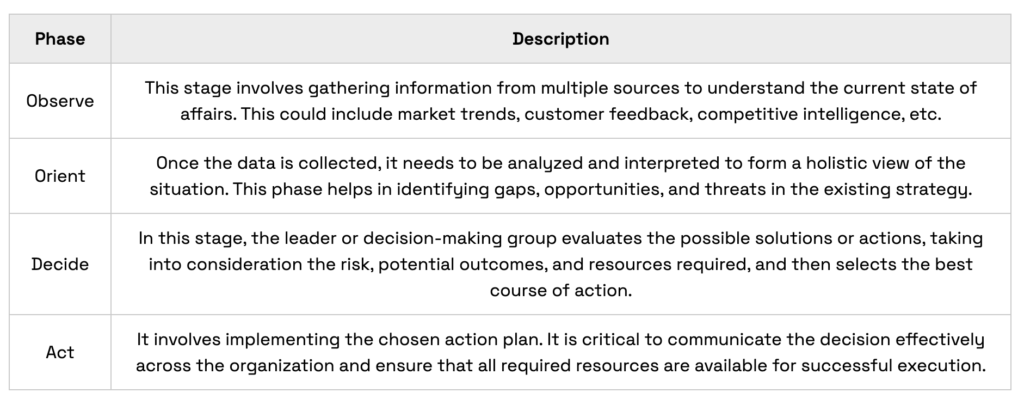
In an era where business landscapes shift overnight, the ability for the C-suite to make quick, data-driven decisions is not just an advantage—it is a necessity.
The swift pace of digital transformation, globalization, and shifting politics have led to an unpredictable business landscape. In these conditions, old-fashioned decision-making methods, defined by extended discussions and agreement-seeking, become ineffective and can harm a business’s competitive edge and adaptability.
Moreover, businesses today have unprecedented access to vast data giving them real-time, accurate insights into market trends, customer habits, and competitor activity. If used well, this data can help organizations predict disruptive events, adapt to changes dynamically, and seize emerging opportunities ahead of less agile competitors.
According to a survey done by McKinsey, companies that are data-driven are 23 times more likely to acquire customers, 6 times as likely to retain those customers, and 19 times as likely to be profitable!
In this article we’ll explore 10 methods that can accelerate your decision-making process and drive your business forward.
Key Challenges the C-suite Faces During Market Turbulence
One of the key challenges faced during market turbulence is the rapid change in market conditions. This can make it difficult to predict future trends and make informed decisions. The speed at which changes occur can also make it difficult to keep up with the latest information, leading to decisions that are based on outdated data.
Another challenge is the increased risk and uncertainty that comes with market turbulence. This can make it difficult to make confident decisions, as they may be unsure of the potential outcomes. This uncertainty can also lead to a fear of making the wrong decision, which can delay decision-making processes.
Additionally, market turbulence often leads to increased pressure and stress. This can impact decision-making abilities, leading to rushed or impulsive decisions that may not be in the best interest of the company. It can also lead to burnout, which can further impact their ability to make effective decisions.
The point being, decision-making does not just become more critical during uncertain times, but it also becomes harder to execute. Guesswork, and misinterpretations across teams or data points can serve as deciding moments for companies.
Setting the Stage to Make Faster, Data-Driven Decisions
The C-suite should start by establishing a strong data infrastructure. Especially since organizations that leverage data in their decision-making processes are twice as likely to have top-quartile financial performance. To execute on this means having the right tools and systems in place to collect, process, and analyze data. It is crucial to ensure that the data is accurate, reliable, and accessible to those who need it.
Fostering a data-driven culture within the organization is key. This means encouraging all employees, not just those in leadership positions, to use data in their decision-making processes. This could involve training staff on how to use data tools or making it a point to include data in discussions and meetings.
Another important step is to prioritize decisions that need to be made. Not all decisions are of equal importance, and it is crucial to identify which ones will have the most impact on the company. This will allow executives to focus their efforts on where they will be most effective.
It is important for leaders to be open to new ideas and approaches. In times of market turbulence, the traditional ways of doing things may not be the most effective. Being willing to experiment with new strategies and techniques can lead to more efficient and effective decision-making.
10 methods for practicing strategic decision-making
1. Leveraging Big Data and Analytics
The role of big data and analytics has been transformative in the realm of business decision-making. It allows for swift, data-informed decisions by revealing patterns and trends associated with human behavior.
Using big data helps companies foresee market trends, recognize opportunities and risks, and adapt their plans as needed. This improves the speed of decision-making, shifting the C-suite’s role from a reactive problem fixer to a proactive planner.
Applying analytics ensures that the decisions are based on solid data rather than hunches, boosting the company’s proactive stance. Employing strategies like predictive analytics can transition businesses from being ‘hindsight-driven’ to ‘foresight-driven’. This means predicting future events based on past data.
Implementing effective use of big data and analytics involves creating a robust data infrastructure, fostering a data-conscious culture, and investing in adequate analytics tools, platforms, and skills development. Real-time data analysis can help the C-suite make faster decisions by providing up-to-date information.
Leadership embedded in data-driven decision-making can successfully navigate the turbulent market, transforming uncertainty into a pathway for growth.
“Without big data, you are blind and deaf and in the middle of a freeway.”
– Geoffrey Moore
2. Adopting Agile Decision-Making Processes
Agile decision-making processes are essential in improving the pace and reliability of decisions. These methods encourage flexible and iterative decision-making, including regular feedback and adjustments to keep the action plan updated. Rather than focusing too much on detailed planning and control, agile decision-making advocates for small and gradual changes which boost efficiency and adaptability.
Ultimately, adopting agile decision-making processes helps C-suite executives navigate turbulent market conditions by enabling rapid changes in response to evolve scenarios. Giving the organization a competitive edge, it allows them to stay ahead of uncertainties and yield higher-quality decisions backed by agile processes and data.
3. Enhancing Emotional Intelligence
Leaders with robust emotional intelligence (EQ) deploy their skillset in self-awareness, self-management, internal motivation, empathy, and social skills to navigate uncertain market conditions more effectively. This is due to their aptitude for recognizing personal and group emotions, facilitating informed and swift decision-making.
By managing self-awareness and self-management, leaders are better positioned to counteract biases and minimize personal emotions that impede data-driven decision making. Internal motivation encourages team unification for business continuity amidst market turbulence, while empathy ensures a balanced, human-centric decision-making approach.
Leaders with excellent social skills can communicate strategic decisions clearly to relevant stakeholders, making EQ indispensable for quick implementation of change and retention of employee morale during uncertain times.
4. Utilizing Predictive Modeling
Leveraging algorithms and machine learning techniques can derive predictions from historical and real-time data. Such a strategic tool assists the C-suite in anticipating forthcoming scenarios – therefore, making effective decisions, swiftly.
Notably, the integrity of data utilized becomes critical in predictive modeling as it directly impacts the accuracy of the resulting forecasts. Therefore, establishing impeccable data collection and management systems is pivotal. Predictive modeling is not just a tool but an ongoing process of learning, analyzing, and refining tactics.
This method allows leaders to understand potential risks and opportunities in an in-depth manner, enriching their strategic decision-making abilities. Predictive modeling enables C-suite to be proactive in volatile times, instead of merely reacting to crises as they emerge.
5. Implementing Decision-Making Frameworks
Implementing effective decision-making frameworks is crucial for any executive intending to make rapid, informed decisions. These frameworks deliver an organized approach, providing a comprehensive procedure that injects precision, speed, and consistency into the decision-making process.
The application of such systems enables leaders to judge situations based on pre-established assessments and avoid relying solely on instinct. This consistent evaluation and comparison of options create efficiency, allowing for clear thinking and faster decision-making. Moreover, decision-making frameworks foster greater transparency and accountability, strengthening trust among stakeholders.
Examples of these frameworks include OODA (Observe, Orient, Decide, Act), DECIDE model, and the Eisenhower Matrix, each providing their unique mechanism. Depending on the company’s nature and context, leaders must choose the most fitting model to fortify their decision-making abilities, especially during turbulent market conditions.
Here is a breakdown of the OODA model for reference:

6. Fostering a Culture of Open Innovation
Fostering open innovation, the practice of utilizing both internal and external ideas, can significantly improve the speed and efficacy of decision-making. This broader range of insights empowers C-suite to make quick, informed choices that adjust to fluctuating market dynamics.
Promoting this culture implies encouraging a free flow of ideas across all organizational sectors – from employees to partners, stakeholders, and customers. It enables the generation of diverse ideas, which can quickly feed into decision-making processes, thus enhancing responsiveness.
A well-implemented open innovation culture emphasizes external networking, cross-departmental co-operation, openness to various ideas, and a commitment to leveraging collective wisdom. By appropriately using open innovation, C-suite gains a significant advantage in making quicker, data-driven decisions.
7. Practicing Decisive Leadership
In uncertain market conditions, C-suite executives are compelled to adopt swift and informed decision-making, while not sacrificing the quality of resolution processes. Their main abilities involve being clear, decisive, and future-focused. This allows them to make sense of various data, stay updated with market changes, and make bold decisions that promote successful strategies.
Outlined below are a few key aspects that underscore the essence of practicing decisive leadership:
- Embrace uncertainty: Uncertainty is an undeniable reality, especially in the business world. A decisive leader embraces this ambiguity and continues to make firm and timely decisions, implementing these when required. Being able to make decisions on the fly, when circumstances dictate, keeps businesses agile and poised for success.
- Build resilience: Quick, tough decisions can lead to outcomes that were not initially envisioned. In such cases, resilience becomes key. Business leaders need to show fortitude during challenging times, learning from setbacks, and adapting their strategies accordingly.
- Communicate effectively: Decisive leaders not only make decisions swiftly but also ensure that these decisions are clearly understood by the entire team. Adequate communication of ideas and problems builds trust, aligns staff with the company’s objectives, and motivates employees to align with the final decision.
8. Emphasizing Customer-Centric Decision-Making
It’s vital to apply customer-centric decision-making in today’s complex markets. This requires thoroughly understanding customer needs and using modern analytics and data collection tools. Tools like Sapta’s Engage can help you gather and collaborate on customer feedback, ideas, and insights. Doing so not only enhances your competitive edge but also improves your company’s overall performance.
Incorporate this methodology across all business verticals, advocating for the integration of customer insights into both operational and strategic deliberations. The shift might be resource-intensive, yet the ensuing agility, innovative prowess, and alignment with customer necessities are considerable advantages.
Turning your company into a customer-focused organization takes strategic planning and time. It is about merging people, processes, and technology all working towards the same goals. Staying committed to these goals, especially during uncertain times, shows your company’s ability to adapt and remain stable.
9. Building a Scalable Decision-Making Infrastructure
Building a scalable decision-making infrastructure is no longer an option but a necessity in the face of volatile market conditions. This type of setup combines strong tech systems, analytics tools, and decision-making methods, helping a business to become more adaptable and tough.
Real-time data analysis can help the C-suite executives make faster decisions by providing up-to-date information. This centralization of data aids in unifying the organization’s decision-making process, thereby eliminating silos, and improving synchronization. Products like Allocate can provide data-driven decision recommendations to streamline the decision-making process. Technology tools like AI, machine learning, and cloud computing play a pivotal role in creating such an infrastructure.
But it is essential to ensure that this new infrastructure works well with your existing systems and can adapt to future changes. Recognizing that this investment will lead to better, faster, and more efficient decisions is key.
10. Enhancing Risk Management and Mitigation
Risk Management is a key ingredient in a successful adaptive strategy. An effective strategy involves not just identifying potential issues but also quickly developing proactive responses.
Advanced data analytics can further improve decision-making speed and quality in risk management. This tool allows leaders to effectively synthesize past data, anticipate future risks, and strategize to reduce impacts.
During market instability, obtaining a holistic understanding of your targets, notable outcomes, and financial plans with real-time data is paramount, this is best accomplished through a unified system such as Adapt. Through its adaptive scorecard, strategic alterations can be simulated and analyzed across a dozen crucial business aspects. This means decision-making is improved with better foresight and accuracy.
Every leader should aim to create a setting where measured risks are seen not as threats, but as forces for change and innovation.
Adapt Your Decision-Making with the Market
The volatility of today’s market requires an evolution in decision-making practice. Traditional methods are becoming less effective and requiring leaders to modernize their approach to an adaptive strategy.
Using these methods means smarter, quicker, and more effective leadership. By relying on data and predictive models for decision-making, companies no longer operate merely on instinct. Shifting towards more adaptable procedures helps companies keep up with changing markets and customer needs. Also, constant learning and skill development help employees stay aligned with the company’s goals.
Today’s leaders must use these cutting-edge strategies for efficient decision-making. C-suite executives lead this change by steering their companies towards an era of data-informed and swift decisions. This creates a strong company, prepared to succeed in an environment of unanticipated changes.
Follow us on LinkedIn for all the latest Adaptive Insights.



